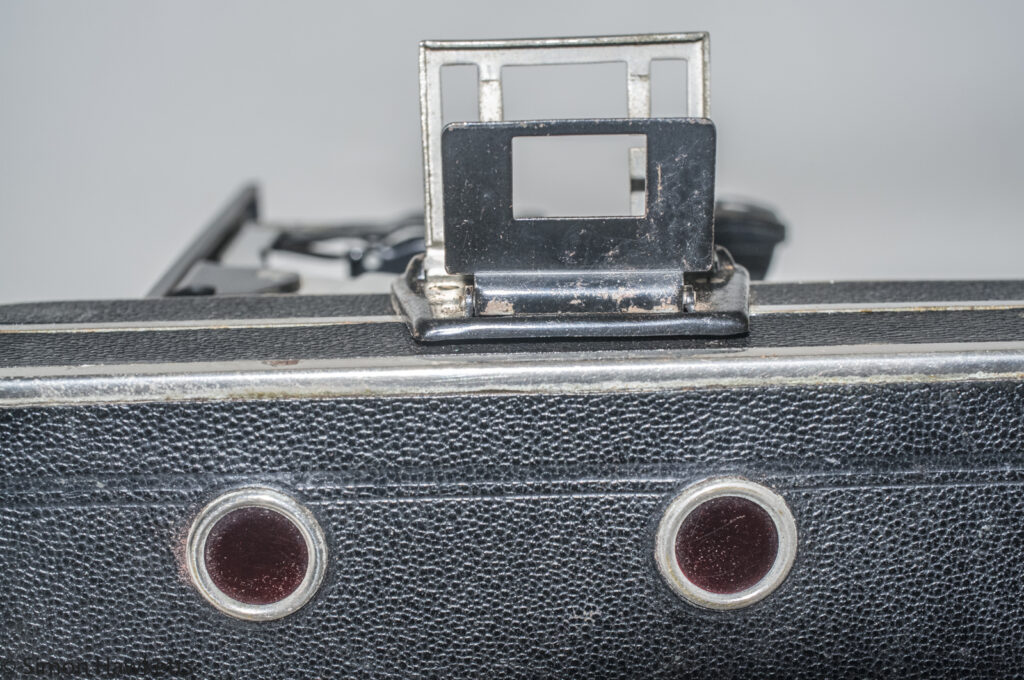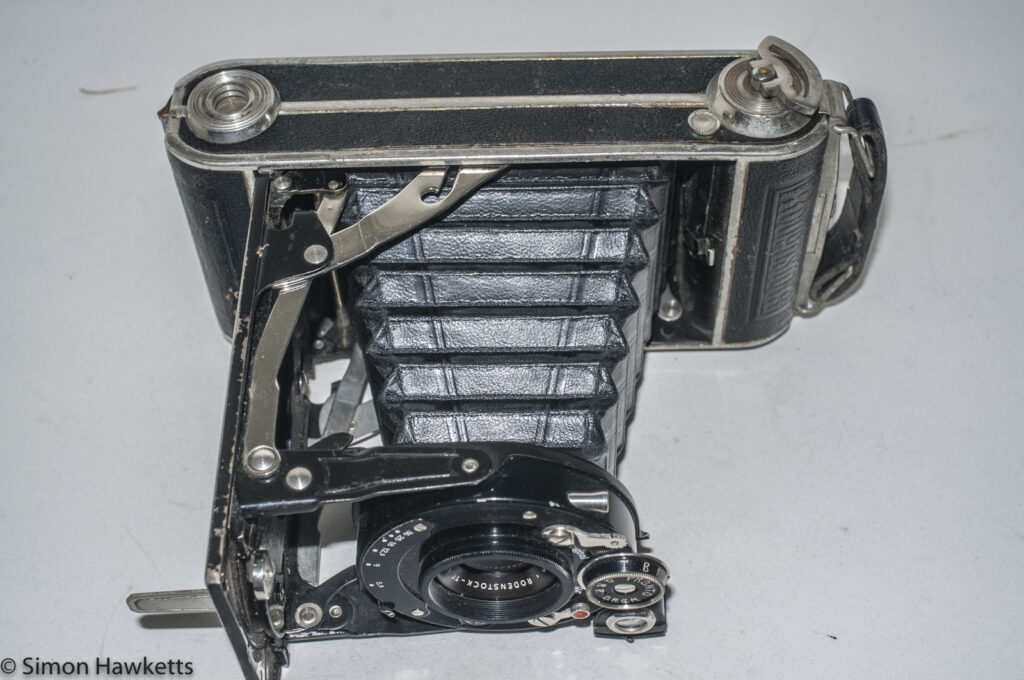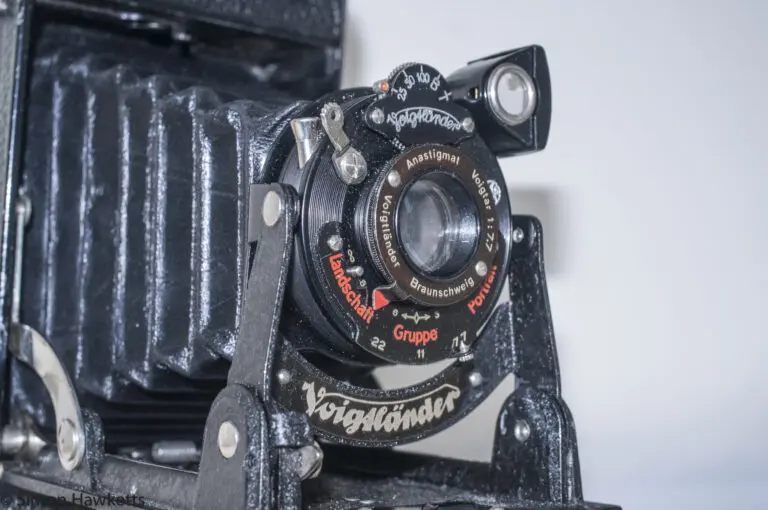Rodenstock folding camera
This is a review and description of a Rodenstock folding camera which I recently bought from eBay UK. Rodenstock has a good reputation for producing lenses, being the original manufacturers of some of the lenses in the Kodak Retina series of cameras, but this is the first camera I’ve seen made by the company.
Rodenstock Folding Camera Images










My Rodenstock Folding Camera
This is the third folding camera I’ve bought in the last few weeks. The other two were a Voigtlander Bessa and a Butchers which are iconic makes, and this camera, being a Rodenstock makes it a trio of famous manufacturers.
I assumed that since Rodenstock are famous for making lenses rather than cameras it should be relatively easy to find the model with a quick internet search, but I couldn’t find any reference to any models they made, so I don’t actually know which model this unit is.
It does seem to be in good order though, with light tight bellows and back film door as far as I can see. The shutter certainly works at all speeds, although the self-timer is a bit reluctant to run down and needs to be helped a bit.
The general cosmetic condition is pretty good considering the camera’s age which, although I don’t know the model and therefore can’t be certain, I would think would be between 1920 and 1935.
Rodenstock Folding Camera Description
The general construction of this Rodenstock folding camera is similar to many other cameras of the same era. The body of the camera is a light tight box which holds the two film reels and allows the film to be drawn across the back of the camera. At the front is a fold down flap which, when it is opened, pulls the shutter assembly out on a set of expandable bellows. Using this construction, a lens with the right focal length to create the correct size image can be fitted in a camera which is much smaller than would otherwise be possible.

One way this camera differs from many folding cameras is in the focusing arrangements. Normally the focus is set by turning the front lens element, but in this camera the whole of the lens / shutter assembly is moved in and out by way of a lever assembly at the front of the camera. This lever has a scale written next to it, which allows the photographer to set the distance. There is no rangefinder or other aid to measure the distance to the subject, but I suspect photographers became good at estimating distances when they needed to regularly do it.
The settings for the exposure are set with the aperture and shutter speed levers, and these are also on the front of the shutter assembly. The aperture setting is adjusted with a lever on the bottom of the shutter and can be set between f/5.6 to f/36. The shutter is a Pronto model and the shutter speed is set with a rotary control positioned at the top of the shutter. There are only a limited number of speeds available – 1/25, 1/50, 1/100 and bulb + time.
Other options available on the shutter are a threaded cable release socket and a self-timer lever.
To compose the picture there are, in common with many folder cameras, two viewfinder options. A small viewfinder is fitted to the shutter which can be turned to either landscape or portrait orientation and a frame finder is fitted to the top of the camera with a fold up framing square.
Inside the camera body, the film chamber has protective shields which hold the film rolls in place, which need to be swung up out of the body to load the film. Presumably the shields are to ensure the film is held securely wound and therefore light tight when the film is removed from the camera.
The most noticeable oddity regarding the film loading is the fact that there are two frame number apertures in the back panel, and they are in-line.
It’s not unusual for medium format cameras to have multiple frame number holes, but they are normally in different vertical positions and are for cameras which can take different numbers of pictures.
For example, if the camera takes 16 pictures of 4.5 cm x 6 cm the camera will use one set of numbers on the film packing paper, or if it takes 12 pictures of 6xm x 6 cm it will use a different set. Therefore, cameras which can take either format will have two sets of holes in different vertical alignment. On this camera, however, the two holes are in-line, and I can’t think why this would be – if anyone knows the reason for this I’d be interested to hear.
Update: The answer for this is below in the comments.
I now have a number of large negative, medium format cameras, and I’m going to try a roll of film through one of them to see what sort of results they are capable of. With a Rodenstock lens, this camera may well be a good candidate for that test.
Rodenstock Folding Camera Specification
- Large negative, medium format camera which takes 120 film
- 8 pictures of 6cm x 9cm
- Quick release front lens door
- Self cocking Pronto shutter
- Shutter speeds 1/25, 1/50, 1/100 + Bulb & Time
- Mechanical Self timer
- Cable release socket on shutter
- Portrait / Landscape viewfinder & frame finder
- Front focus adjuster
- Aperture f/5.6 to f/36
- Rodenstock Trinar Anastigmat 105mm f/5.6
- Fold down support strut
- Tripod on front door and camera bottom
Discover more from Everything Vintage
Subscribe to get the latest posts sent to your email.





